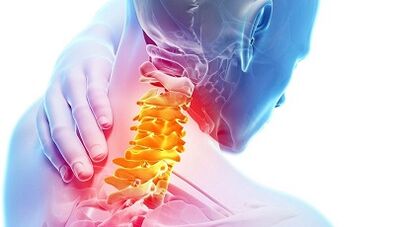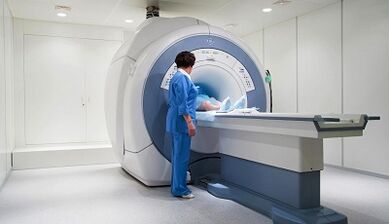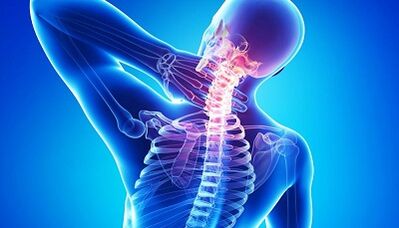Among all disorders of the musculoskeletal system, the second place in the spread is occupied by osteochondrosis of the cervical spine.The symptoms and treatment of the disease are determined by the stage of its development, so it is so important that you do not miss the signs of an upcoming disease.
Causes and symptoms of osteochondrosis of the cervical spine

Osteochondrosis is called dystrophic changes in the joint cartilage against the background of the lesion of the intervertebral discs.
Cervical osteochondrosis is characterized by the pathological destruction of the cartilage tissue of the vertebrae that support the head.
Most often, the disease is diagnosed in people aged 30 to 40 years.In developed countries, this or other degree of cervical osteochondrosis is diagnosed in 80% of the population.
The neck is considered to be the most movable spine.At the same time, there is insufficient muscle around the neck, which can compensate for the loads of the spine.Therefore, the greater part of the loads falls on the intervertebral discs that play the role of absorbing stroke.
As a result, the discs wear, dry and equal, osteochondrosis develop.
The reasons that contribute to the onset of pathology lies not only in anatomy but also in human behavior:
- Soweity and static, stuck work - on the computer, driving a car in the office;
- Excess weight;
- High exercise;
- smoking;
- malnutrition;
- weak physical form;
- Injuries to the spine.
Additional provocative factors for the development of osteochondrosis are: flat legs, soft mattresses and pillows, the habit of wearing a bag on the shoulder, hypothermia and stress.
How the disease manifests itself
At the beginning of the disease for its development, only the flow of the neck, which is usually not paid attention.With the progress of the pathology, the number and intensity of manifestations increases.
Characteristic symptoms of cervical osteochondrosis occur:
- Pain in the back of the head, at the base of the neck, giving the limbs;
- crunch and tenderness when rotating the head;
- tingling or tingling of the areas between shoulder blades and at the base of the neck, burning, feeling of discomfort and stiffness;
- headache, migraine, dizziness;
- Weakness, fatigue.
Secondary symptoms are considered to be reduced by vision, hearing, memory problems, sleep disturbance, inattention, scattering, pressure.
Syndromes caused by osteochondrosis of the cervical spine

Doctors classify the signs of osteochondrial processes such as syndromes associated with a particular type of spine.
Stenosis.It develops against the background of the hernia of the intervertebral discs and is accompanied by a disorder of blood circulation and bone growth.It is manifested by numbness of the limbs.
Reflex and irritation syndrome- a consequence of the compression of the spinal artery with a curvature of the neck and impaired posture.It manifests itself in severe paroxysmal pain in the back with a gradual spread in areas around the forehead.
Rook syndrome.It is observed when the spinal roots are aligned - the effects of hernia.At the same time, sensitivity in the affected areas is reduced and motor activity becomes limited.It can be accompanied by the development of speech defects, snoring, impaired odor, reducing the sensitivity of the muscles of the tongue.
The degree of development of cervical osteochondrosis
The complexity of the process of the processes is determined by the condition of the pulpulated nucleus, which fills the vertebrae.
The degenerative lesions of the cervical region are conditionally divided into three stages:
- First.The intervertebral disc is compacted.Hooks of the vertebrae of the vertebrae are increasing.Muscle stiffness appears, but their mobility does not change.Little edema and headache are possible;
- The second.It develops against the background of progress in the first stage of the disease if the treatment of osteochondrosis of the cervical spine has been absent or performed incorrectly.The intervertebral openings are narrowed, the height of the intervertebral discs becomes smaller due to their equalization.He presses nerve roots.The patient experiences painful pain;
- The third.The cracks in the fibrous ring surrounding the intervertebral disc lead to a rupture of its capsule and deformation of the muscle tissue.The stability of fixing the nucleus of the pulp inside the intervertebral disc is disturbed.An intervertebral hernia develops.It is characterized by acute neck pain, tingling of the tongue, edema, limiting mobility, curvature of the spine.
The proper position of the vertebrae of the cervical region determines the functionality of the visual and auditory nerves, nose, lips, mouth, throat, teeth, facial nerve, pituitary, brain, parasympathetic nervous system, neck muscles and forearm, thyroid, elbow and shoulder joints.
Diagnostic methods

The accurate determination of the cause of the development of osteochondrosis allows you to deliberately influence the disease.The preliminary diagnosis was indicated after the initial examination by the doctor.
The patient's complaints about the nature of the pain syndromes are taken into account, as well as the information obtained during the spinal study in different positions.The test of the cervical compartment allows you to determine the presence of seals and deformities.In addition, the attention is paid to the tone of the patient's muscles and motor capacity.
Doctors receive complete diagnostic information using such studies as:
- Radiography.The procedure allows you to evaluate the condition of the vertebrae in two projections - straight and side.The result is the determination of damage, physiological deposits and compacted formations;
- Magnetic resonance imagingAllows you to identify not only any pathologies of the spine, but also the degree of severity.Through the MRI, the doctor can evaluate the condition and level of damage to the nerve endings, blood vessels and intervertebral discs;
- Computed tomography- Digitalization of information obtained by X -ray irradiation.
In the presence of dizziness, further study of the structural change in blood vessels may be required through homemade, angiography and duplex.
How to treat osteochondrosis of the uterus?
After making an accurate diagnosis and clarifying the causes of the disease, the neurologist determines how to treat osteochondrosis of the cervix.
The optimal results are worn through complex therapy, which provides for the use of several methods.Protocols include drug effects, hardware procedures, exercise and therapeutic massage.
Medication

In each case, the choice of medicines occurs individually.It depends not only on the severity of the pathology, but also on the specific characteristics of the patient's body.
Fixed drugs for drug treatment:
- anti -inflammatory drugs - tablets that relieve pain and inflammation;
- Chondroprotectors - medicines that activate the regeneration of cartilage tissue;
- External use - ointments and gels that stop pain and inflammation;
- A complex of vitamins to maintain the body and stimulate its recovery.
In the first stage of the therapeutic effect, it is possible to increase the pain syndrome - this is the reaction of the muscular system.Physiotherapy procedures are used to reduce discomfort and improve the results of drug treatment.
Physiotherapy
Physiotherapy means an effect on the cause of the disease with the help of special equipment - electrophoresis, tissue electrical stimulation.The use of low frequency currents improves blood circulation in the affected areas, relieves edema and pain and at the same time increases the effectiveness of medical effects.
The minimum course of hardware processing is 10 sessions.
Cervical osteochondrosis massage at home
Manual therapy is a productive way of affecting the affected areas at home.With the help of massage, pinching, muscle cramps and pain are eliminated, blood circulation improves and compression of nerve roots is reduced.
Thanks to the massage, metabolism improves and the tissues of the spine are restored.
Media physical education for osteochondrosis of the cervical spine
The best method for restoring the functionality of the organs of the musculoskeletal system and the prevention of relapse is the physical education of physiotherapy for osteochondrosis of the cervical region.The procedures are prescribed after completely relieving pain and inflammatory processes.
The main types of exercise:
- medical gymnastics;
- dosed walking;
- simulator classes;
- swimming.
In order for cervical osteochondrosis exercises to achieve the expected results, the classes must be conducted under the supervision of competent professionals.
Folk remedies
Complete elimination of cervical osteochondrosis with the help of traditional medicine methods is impossible.On the other hand, the use of folk remedies allows you to improve the patient's condition, relieve inflammation, reduce pain and strengthen immunity.
The average therapeutic period with cervical osteochondrosis takes up to three months.If conservative treatment did not lead to the expected results, surgery is used.
Why is cervical osteochondrosis dangerous?

Neck pathologies are a serious threat to all human health.As the neck connects the head to the body, there are all important biological communications in this area of the spine - arteries that feed the brain, nerve ducts.
Any changes in the functionality of the cervical region lead to the consequences in the form:
- Disorders of blood circulation and nutrition of the brain.As a result, hypertension, pathology of the respiratory system and cardiovascular system, VSD, impaired coordination, hearing problems, vision and speech develop;
- Spinal artery syndrome.The pathology develops against the background of compression of a vessel that feeds the brain and the ongoing brain.The development of cervical osteochondrosis can cause ischemia and stroke;
- Radiculopathy - damage to nerve roots, bone growth on the vertebrae, resulting in partial or complete loss of mobility.
The most dangerous compression of the spinal cord, which is located inside the spine.Such pathology leads to a rupture of the spinal cord sheath and causes paralysis.In particularly severe cases, cervical osteochondrosis ends fatal.
Prevention
Even after a complete recovery, the disease can return again if the patient does not review his lifestyle - way of work and rest, habits, food.
As preventative measures, neurologists recommend paying attention to the following points:
- The hardness of the mattress.The ideal option is an orthopedic mattress and a low pillow;
- Visit to the sauna is necessary for complete relaxation and removal of muscle cramps;
- Daily hot shower is a good tool for improving the circulation of the neck;
- Swimming, walking, stimulates blood circulation, strengthens the muscles of the spine;
- Proper nutrition is to reject products that slow down metabolism: fat, fried, sweet, smoked, flour and alcohol.Dishes with gelatin, dairy, nuts, vegetables, white meat, seafood are recommended.

In everyday life, high physical exertion, sharp turns of the head, prolonged sitting or in a static position should be avoided.In addition, it is desirable to use chairs that provide support for the head and back.
The active life position, healthy food and morning exercise are simple, but effective ways to avoid most illnesses and live a long life without pain and discomfort.


















